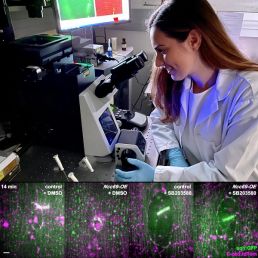The science of rapid wound healing has new insights due to discoveries in fruit flies from the Fernandez-Gonzalez lab at University of Toronto. The results of their collaboration, community and perseverance were published in the journal Cell Reports as “p38-mediated cell growth and survival drive rapid embryonic wound repair”. Congratulations to Gordana Scepanovic who earned the 2022 Christina Hone-Buske Scholarship for this ground-breaking work!
The Fernandez-Gonzalez lab in Biomedical Engineering use lasers to cut cell membranes in the fruit fly embryo. They have developed image analysis techniques to examine the dynamics of wound repair as the lesion expands, then contracts to seal the damage. Their techniques show that the actin and myosin II cytoskeletal proteins polarize to form cables around the wound which draw the wound shut to limit the risk of infection and tissue loss.
As a result of a chat with Ran Kafri, a cell signaling specialist at SickKids Hospital, Fernandez-Gonzalez considered targeting p38 in embryos, since in adult flies the p38 signaling protein is involved in responses to tissue damage. His student Miranda Hunter used a chemical inhibitor of p38 in embryos and was excited to find that inhibiting p38 resulted in a delay in wound closure.
Hunter has since graduated with a PhD from Cell & Systems Biology (CSB), and passed this result to new CSB PhD student Gordana Scepanovic to take on a deeper study of this observation. Scepanovic altered p38 chemically and genetically and used all the tools in the lab to look at the contractile cytoskeletal apparatus around the wound. She went through months of frustration as the properties of the cytoskeleton didn’t change no matter how she disrupted p38.
After long hours of perseverance at the microscope, Scepanovic had the amazing insight that although the cytoskeletal ring wasn’t altered by p38 disruption, the size of the cells around the wound looked different. In addition, disruption of p38 reduced survival in cells adjacent to the wound.
Scepanovic decided to measure cell size and survival in her fly embryos, confident from her previous “negative” results that the contractile ring was unaltered. This meant she was breaking new ground for her lab and needed new means to measure these metrics.
As they attended a scientific conference, Scepanovic and Fernandez-Gonzalez reviewed the talks and posters they had seen and determined that the most appropriate tool in the community was the membrane bound Resille protein that could outline the periphery of the cell to allow measurement of cell height.
Scepanovic’s insight was shown to be correct: cell height was unchanged, while cell surface area expanded after wounding, confirming that the volume of the cells around the lesion increased during wound repair. In fact, the actomyosin cytoskeleton was not sufficient to close the wound if cellular swelling was blocked. She identified the NKCC ion transporter as an important p38-regulated component of cellular swelling.
Scepanovic also found that wounds were excessively large when she inhibited p38. Hunter had previously studied the role of Reactive Oxygen Species (ROS) in promoting formation of the contractile ring, so Scepanovic looked at ROS in cells with altered p38. She found that p38 plays a key role in the regulation of ROS during wound repair, allowing sufficient ROS production for cytoskeletal polarity, but not enough to damage cells.
These fundamental insights put p38 at the centre of a complex web of wound repair mechanisms and may lead to new pharmacological interventions to promote rapid tissue repair by targeting p38 and associated regulators.

